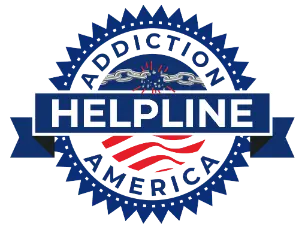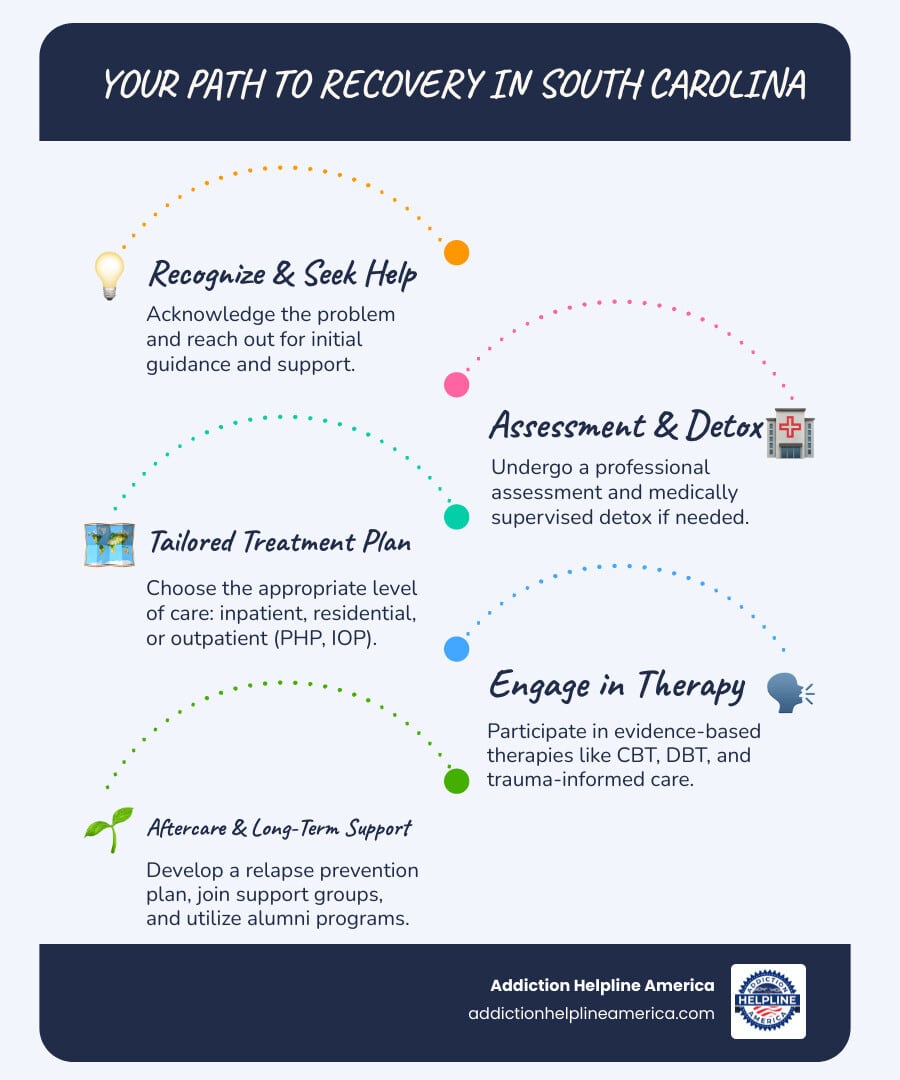
Understanding Adolescent Substance Abuse: A Parent’s Starting Point
Adolescent substance abuse affects millions of families, but many parents feel unprepared to face it. The statistics are sobering, but understanding the issue is the first step toward effective prevention and intervention.
Key Facts About Teen Substance Use:
- 15% of high school students have used illicit drugs like cocaine, heroin, or methamphetamines.
- 14% misuse prescription opioids without a prescription.
- 59% of 12th graders have consumed alcohol by graduation.
- 1 in 6 adolescents used an illicit substance in the past year.
- 90% of adults with substance use disorders started using before age 18.
The teenage years bring unique vulnerabilities. An adolescent’s brain won’t fully mature until their early twenties, with decision-making centers developing last. This biological reality, combined with social and emotional pressures, creates a high-risk environment for experimentation that can lead to dependency.
Teens may use substances to fit in, cope with stress, or self-medicate mental health issues. The good news is that adolescent substance abuse is both preventable and treatable when parents have the right information and support.
Addiction Helpline America has helped thousands of families steer teen substance abuse with our 24/7 helpline and treatment referral services. We know that informed parents are the most powerful force in protecting their children.
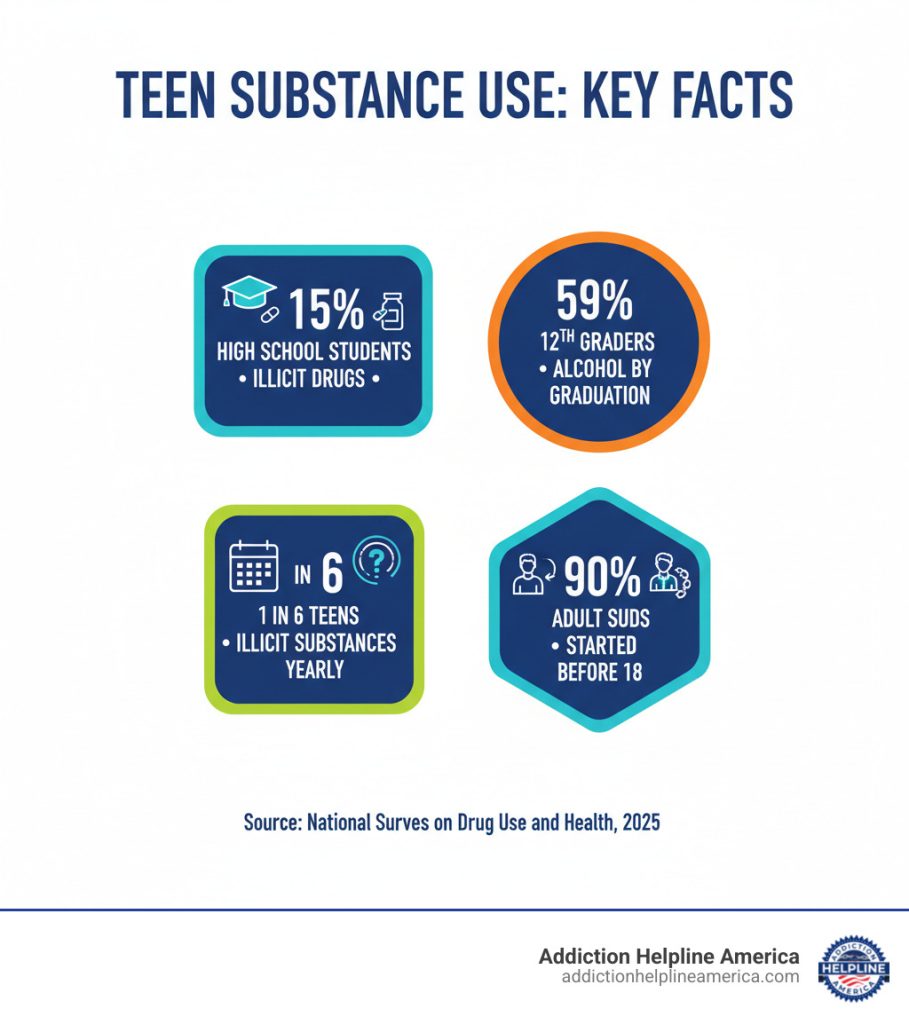
The Modern Landscape of Teen Substance Use
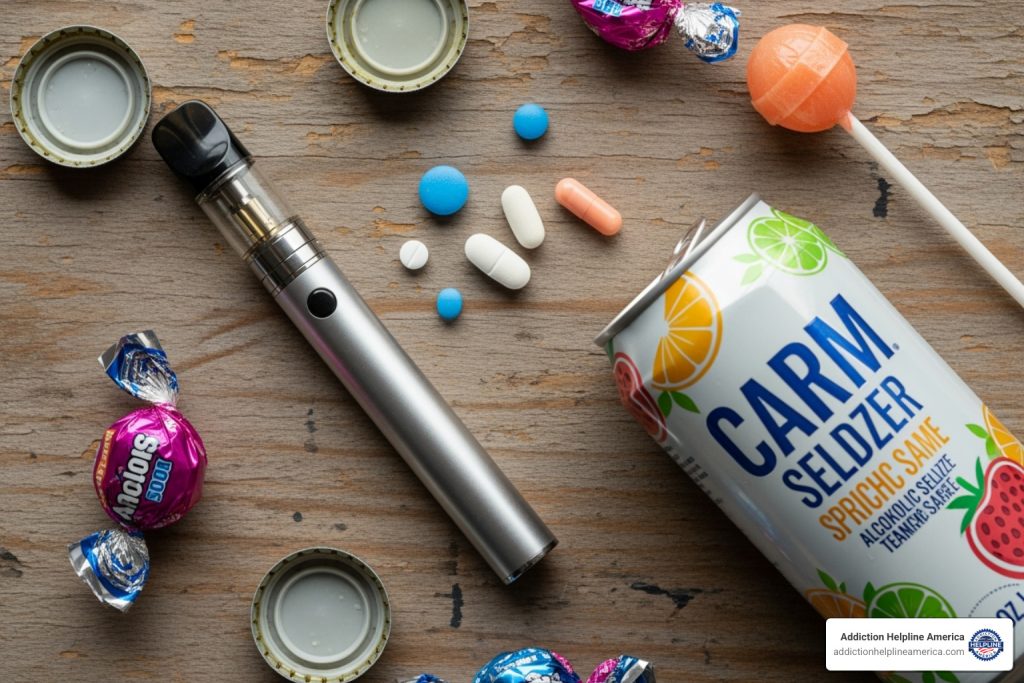
The landscape of adolescent substance abuse has shifted dramatically. While some substances remain popular, new threats have emerged that can catch parents off guard. Understanding what teens are actually using is essential for staying ahead of potential problems.
Common Substances and Changing Trends
Alcohol remains the most common substance used by teens. By 12th grade, 59% have consumed alcohol. The pattern of binge drinking—consuming four to five drinks in a short period—is particularly concerning and has become a typical way teens drink.
Marijuana is the most popular illegal drug among teens, but today’s high-potency THC products create higher risks for dependency and mental health issues than in the past.
Vaping has revolutionized how teens consume nicotine and cannabis. Since 2014, more teens have used vaping devices than traditional cigarettes, drawn by sleek designs, appealing flavors, and the false belief that vaping is safe. Many don’t realize they are consuming addictive nicotine.
Prescription drug misuse is a dangerous trend, with 14% of high school students having misused prescription opioids. Stimulants (ADHD medication) and opioids from family medicine cabinets are often seen as safe because they are prescribed by doctors.
Less common but still dangerous are hallucinogens and inhalants, which can cause immediate, severe harm. For more details, the NIDA for Teens resources and the CDC data on underage drinking are excellent sources.
The Influence of Social Media and Peer Culture
Social media has fundamentally changed how teens view substance use. Platforms like TikTok feature vaping influencers who make nicotine addiction look trendy, creating a powerful form of digital peer pressure that operates 24/7.
This constant exposure leads to the normalization of use. When teens see influencers and celebrities glamorizing substances, their perception of what is acceptable shifts. Research on social media and vaping confirms that exposure to this content makes teens more likely to experiment.
Misinformation also spreads rapidly, with posts claiming vaping is harmless or that certain drugs are safe because they’re “natural.” This can lead teens to overestimate how many of their peers use substances, believing “everyone is doing it.”
Parents can counter this by having open conversations about what teens see online. Help them develop critical thinking skills by discussing how influencers are often paid and that shocking content gets more views than accurate information. Staying informed about the platforms your teen uses is key to maintaining trust and open communication
Why Adolescents Are at Higher Risk for Substance Abuse
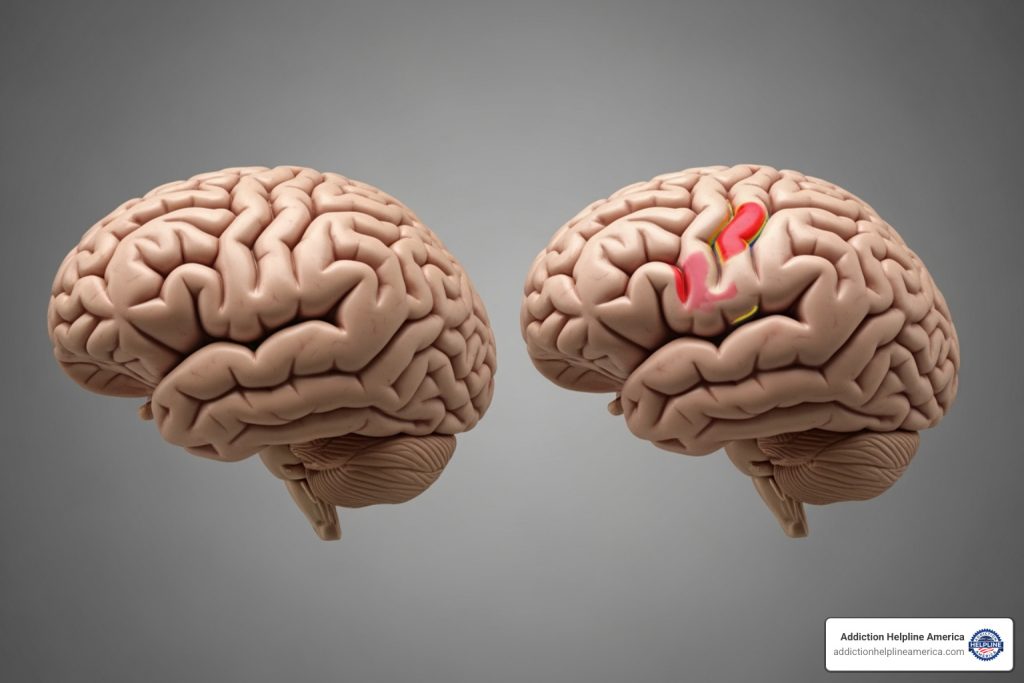
The teenage years create a perfect storm of biological and psychological factors that make adolescent substance abuse more likely. It’s not about being a “bad kid”; the reality is rooted in science. Understanding these factors helps you approach your teen with compassion while taking the risks seriously.
The Developing Brain: A Key Factor in Adolescent Substance Abuse
Your teenager’s brain won’t be fully mature until their early twenties. The limbic system, which drives emotions and reward-seeking, develops faster than the prefrontal cortex, which is responsible for judgment and impulse control. Think of it as a car with a powerful gas pedal but underdeveloped brakes.
This developmental gap makes teens biologically wired to seek excitement and take risks, with a reduced ability to consider long-term consequences. Their brains are more sensitive to the rewarding effects of drugs and alcohol.
Because the brain is still developing, substances can interfere with its healthy growth, potentially causing lasting changes. Research on adolescent brain development and substance use shows that early use significantly increases the lifetime risk of developing a substance use disorder.
Key Risk Factors and Co-Occurring Disorders
While brain development sets the stage, other factors increase the risk of adolescent substance abuse.
- Family history and genetics: A family history of addiction can create a genetic predisposition.
- Peer groups: Teens who associate with friends who use substances are far more likely to try them.
- Academic pressure and trauma: Some teens use substances to cope with stress or adverse childhood experiences (ACEs).
- Mental health conditions: Between 37% and 80% of teens with substance use disorders also have a co-occurring mental health condition like ADHD, depression, or anxiety.
The “self-medication hypothesis” suggests that teens may use substances to manage underlying issues. For example, a teen might use marijuana to quiet anxiety or alcohol to feel more social. This means addressing the root cause is as important as stopping the substance use.
Recognizing these risk factors isn’t about blame. It’s about understanding that substance use often signals a deeper struggle. With the right support, both issues can be treated effectively.
Recognizing and Addressing Adolescent Substance Abuse

As a parent, you know your teen best. The challenge with adolescent substance abuse is that many warning signs mimic typical teenage behavior. The key is to recognize concerning patterns, not just isolated changes.
How to Identify a Potential Problem
Pay attention when changes in your teen’s behavior persist or happen all at once. Look for these patterns:
- Behavioral and Social Shifts: Suddenly dropping old friends for a new crowd, losing interest in hobbies, becoming unusually secretive, or having an unexplained need for money.
- School Performance: A sudden drop in grades, increased absences, or reports of behavioral issues from teachers.
- Emotional Changes: Unusual irritability or aggression, dramatic mood swings, or periods of emotional numbness.
- Physical Signs: Changes in sleep or appetite, poor hygiene, unusual smells on breath or clothing, red or glazed eyes, or unexplained weight changes.
If you see these signs, don’t panic, but do take them seriously. Healthcare providers use screening tools like the CRAFFT questionnaire and the SBIRT method (Screening, Brief Intervention, and Referral to Treatment) to assess teens. Noticing these signs means your teen may need support. Our teen intervention services can guide you on how to approach your teen effectively.
The Impact of Race, Gender, and Ethnicity
Adolescent substance abuse doesn’t affect all teens equally. Understanding these disparities is crucial for finding the right help.
- Gender: Teenage girls now report higher rates of alcohol use, binge drinking, and substance use disorders than boys, a significant shift from past trends.
- Race and Ethnicity: While White youth often report higher rates of using certain substances, Black adolescents may face harsher consequences within the justice system for similar behaviors.
- LGBTQ+ Youth: These teens are almost twice as likely to use illicit drugs as their heterosexual peers, often to cope with discrimination and rejection.
These differences highlight the need for culturally competent care that addresses the specific stressors and systemic barriers different teens face.
Balancing Confidentiality and Safety in Healthcare
Navigating your teen’s privacy while ensuring their safety is a delicate balance. Teen healthcare privacy laws exist because adolescents are more likely to be honest about risky behaviors if they trust their information will be kept private. In many states, minors can consent to their own substance abuse treatment.
This doesn’t shut parents out. Building trust at home encourages teens to involve you in their care. Healthcare providers are trained to explain confidentiality to both parents and teens, including when they must break it—typically in cases of immediate danger. Partnering with pediatricians and therapists who specialize in adolescent care is key. They can help facilitate family conversations and ensure your teen gets appropriate care while respecting their need for privacy.
A Modern Approach to Prevention, Treatment, and Recovery

The fight against adolescent substance abuse has evolved. Today’s strategies recognize that teens need support and skills, not just lectures. The focus is on what works: evidence-based prevention, custom treatment, and harm reduction.
Moving Beyond ‘Just Say No’: Effective Prevention Strategies
Outdated campaigns like “Just Say No” were largely ineffective because they ignored why teens might be tempted to use substances. Modern prevention focuses on providing honest, factual information to help teens make informed decisions.
Key protective factors include:
- Strong family bonds: Open communication, clear boundaries, and consistent rules create a foundation of trust.
- School connectedness: Feeling a sense of belonging at school and participating in extracurricular activities reduces risk.
- Building life skills: Programs like PreVenture teach teens healthy coping strategies for personality traits that might lead to risky behaviors.
- Honest education: Curricula that discuss both the risks and perceived benefits of substances resonate better with teens.
Dispelling the myth that “everyone is doing it” is also powerful. When teens learn that most of their peers are not using substances, they feel less pressure to experiment. The SAMHSA’s “Talk. They Hear You.” campaign resources offer excellent guidance for parents.
Evidence-Based Treatment for Adolescent Substance Abuse
Treating adolescent substance abuse requires strategies custom to the developing brain. It’s not simply scaled-down adult treatment.
Family involvement is the cornerstone of successful adolescent treatment. Therapies like Functional Family Therapy and Multisystemic Therapy (MST) work with the whole family to improve communication and create a supportive environment for recovery.
Individual therapies are also crucial. Cognitive Behavioral Therapy (CBT) helps teens develop healthier coping skills, while Motivational Interviewing (MI) helps them find their own motivation to change. Because many teens have co-occurring mental health issues, integrated care that addresses both addiction and conditions like depression or anxiety is essential.
While medication options are more limited for teens, buprenorphine is approved for opioid use disorder in those 16 and older. Treatment should last at least three months to support sustained change.
The Role of Harm Reduction and Community Support
While prevention is the goal, harm reduction aims to reduce the most serious consequences when substance use does occur. In an era of fentanyl contamination, these strategies save lives.
Key harm reduction tools include fentanyl test strips and making naloxone (Narcan) widely available. Education on safer use, such as never using alone, also reduces immediate dangers. Creating non-judgmental spaces where teens can discuss their use without fear opens the door for intervention.
Schools, community coalitions, and parent support networks all play a vital role in creating a comprehensive support system. These approaches work together to keep teens safe and guide them toward healthier futures.
Frequently Asked Questions about Teen Substance Use
Finding out your teen is using substances is frightening. At Addiction Helpline America, we hear the same urgent questions from parents every day. Here are answers to the most common concerns.
My teen tried marijuana. Does that mean they have a problem?
Experimentation is different from a substance use disorder. The key is to look for patterns, not isolated incidents. Is use becoming regular? Is it causing negative consequences like failing grades, lost friendships, or legal trouble?
A Substance Use Disorder (SUD) is a medical diagnosis based on specific criteria, including impaired control, continued use despite problems, and physical symptoms like tolerance or withdrawal. Most teens who experiment do not meet these criteria.
Start with an honest, open-ended conversation. If you remain concerned, a professional assessment can provide clarity and guidance.
Can I drug test my teen at home?
While it seems like a simple solution, at-home drug testing often damages trust and creates more problems than it solves. It sends a message of suspicion and can push your teen further away.
Furthermore, home tests can be inaccurate, leading to false positives or negatives. A positive result tells you what happened, but not why your teen is using substances, which is the more important question.
The American Academy of Pediatrics advises against routine drug testing, recommending instead a focus on behavior and open communication. If you are worried, professional screening by a pediatrician or therapist is a much better alternative.
What’s the difference between substance use, misuse, and a disorder?
These terms describe a spectrum of behavior
- Substance use is the broadest term, covering any consumption, including one-time experimentation.
- Substance misuse involves using substances in a harmful or risky way, leading to negative consequences. This includes binge drinking or taking medication not prescribed to you.
- Adolescent substance abuse that becomes a disorder is a medical condition where a teen cannot control their use despite serious negative impacts on their life, health, and relationships.
Understanding where your teen falls on this spectrum helps determine the right response, from education and monitoring to professional treatment.
Conclusion: Taking the Next Step for Your Family’s Well-being
Educating yourself about adolescent substance abuse is the most important first step a parent can take. This guide has shown that while the landscape of teen substance use is complex—shaped by everything from social media to prescription drugs—the path forward is clear.
We’ve learned that the adolescent brain’s ongoing development creates a natural vulnerability. This isn’t a moral failing; it’s biology. Understanding this allows us to respond with compassion and effective strategies. Risk factors like mental health issues or trauma often reveal that substance use is a symptom of a deeper struggle.
Effective prevention relies on strong family connections and open communication, not outdated scare tactics. When treatment is needed, family-centered, evidence-based approaches offer real hope for recovery. In a world with new dangers like fentanyl, harm reduction principles can be life-saving.
90% of adults with substance use disorders started before age 18. This statistic highlights the critical window of opportunity during adolescence. Early detection and intervention can change the entire trajectory of a young person’s life. The brain’s plasticity during these years means that with the right support, teens can and do recover.
At Addiction Helpline America, we know how isolating this can feel. You don’t have to figure it out alone. Our team provides free, confidential guidance to help you understand your options and connect with the right resources for your family.
Whether you’re seeing early warning signs or dealing with active substance use, professional support can make all the difference. The most important thing you can do right now is reach out.
Addiction Helpline America provides free, confidential guidance to find the right program for your teen. Our experienced team can help you explore your options without pressure or judgment.
Find a personalized teen recovery program today.
Your teen’s story is still being written. With the right support, this chapter can be one of healing and hope for your entire family.
Our helpline is 100%
free & confidential
If you or someone you care about is struggling with drug or alcohol addiction, we can help you explore your recovery options. Don’t face this challenge alone—seek support from us.
Programs
Resources
Will my insurance
cover addiction
treatment?
We're ready to help
Find the best
drug or alcohol treatment
center
Are you or a loved one struggling with addiction? Call today to speak to a treatment expert.
